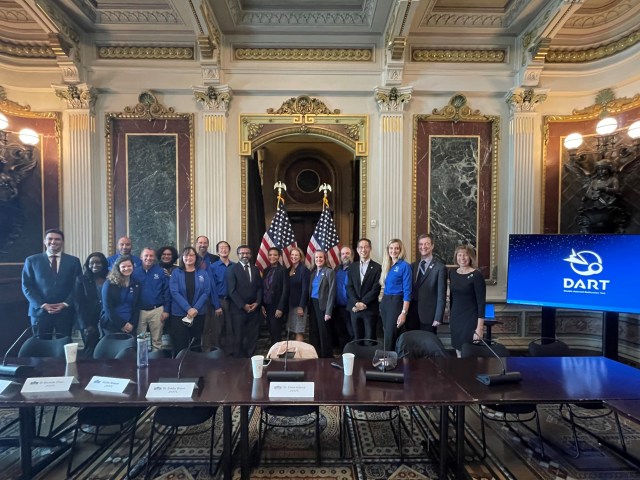Readout of the White House Office of Science and Technology Policy’s Meeting with NASA and DART Mission Team on Results of First-ever Planetary Defense Test

This week the White House Office of Science and Technology Policy (OSTP), alongside leaders from across the Executive Office of the President, welcomed the National Aeronautics and Space Administration (NASA) and the Double Asteroid Redirection Test (DART) team from the Johns Hopkins University Applied Physics Laboratory to the White House to discuss the results of humanity’s first-ever planetary defense test.
The meeting was opened by Dr. Morgan Dwyer, Dr. Alondra Nelson, and Dr. Matthew Daniels, who highlighted the Biden-Harris Administration’s commitment to breakthroughs in science and technology that directly benefit human lives and address global challenges. The discussion focused on results of the first-ever demonstration of asteroid deflection capability – if space tracking systems ever find a hazardous asteroid on a collision course with Earth, the technologies proven by DART could serve as humanity’s first line of defense.
NASA leaders described NASA’s planetary defense mission, the prioritization of planetary defense in the recent National Academies for Science, Engineering and Medicine Decadal Survey of Planetary Science and Astrobiology, the National Near-Earth Object Preparedness Strategy and Action Plan, and the value of international cooperation. The DART Mission Team from the Johns Hopkins University Applied Physics Laboratory—who successfully designed, built, and flew the DART space mission—walked the group through the development process and explained how the DART spacecraft successfully navigated 470 million miles to its target asteroid.
The DART Mission Team also described the worldwide observation campaign to track the asteroid system after the DART impact—including telescopes in Africa, North and South America, Asia, Europe, Oceania, Antarctica, and outer space. The team highlighted the important role of international cooperation in this mission, including the LICIACube small satellite built by the Italian Space Agency, a forthcoming European Space Agency mission in the years ahead, and a broad coalition of observers whose data analysis helped ensure the mission was a resounding success.
During an open discussion, the group explored the future of planetary defense missions, opportunities for new international cooperation, and the continued importance of a whole-of-government collaboration in the United States – including NASA, the National Science Foundation, U.S. Space Command, the Department of Energy, Department of Homeland Security, and the Department of State – to advance planetary defense capabilities and technology.
Background on the DART Space Mission: NASA’s DART spacecraft autonomously impacted its target, the 525-ft diameter asteroid Dimorphos on September 26, 2022. In the following days, a worldwide observation campaign has been underway to determine whether we successfully shifted the asteroid’s trajectory. Those results were released publicly this week, showing the mission was a resounding success — altering the target asteroid’s orbit by four percent, or 25 times more than the threshold needed to be considered a successful demonstration. The DART spacecraft traveled 470 million miles to a 525-foot-wide asteroid that it could not observe until less than an hour before impact. It then autonomously guided itself to within 50 feet of the center of the asteroid at a speed of 14,000 miles-per-hour. The technologies proven by DART could serve as humanity’s first line of defense if a hazardous asteroid is ever found headed toward collision with Earth.
###

